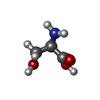Entry Database : PDB / ID : 1pb8Title CRYSTAL STRUCTURE OF THE NR1 LIGAND BINDING CORE IN COMPLEX WITH D-SERINE AT 1.45 ANGSTROMS RESOLUTION N-methyl-D-aspartate Receptor Subunit 1 Keywords / / / Function / homology Function Domain/homology Component
/ / / / / / / / / / / / / / / / / / / / / / / / / / / / / / / / / / / / / / / / / / / / / / / / / / / / / / / / / / / / / / / / / / / / / / / / / / / / / / / / / / / / / / / / / / / / / / / / / / / / / / / / / / / / / / / / / / / / / / / / / / / / / / / / / / / / / Biological species Rattus norvegicus (Norway rat)Method / / / Resolution : 1.45 Å Authors Furukawa, H. / Gouaux, E. Journal : Embo J. / Year : 2003Title : Mechanisms of activation, inhibition and specificity: crystal structures of the NMDA receptor NR1 ligand-binding coreAuthors : Furukawa, H. / Gouaux, E. History Deposition May 14, 2003 Deposition site / Processing site Revision 1.0 Jun 24, 2003 Provider / Type Revision 1.1 Apr 29, 2008 Group Revision 1.2 Jul 13, 2011 Group Revision 1.3 Jul 26, 2017 Group / Source and taxonomy / Category / software
Show all Show less
 Yorodumi
Yorodumi Open data
Open data Basic information
Basic information Components
Components NMDA receptor
NMDA receptor  Keywords
Keywords LIGAND BINDING PROTEIN / Ligand binding receptor /
LIGAND BINDING PROTEIN / Ligand binding receptor /  rat / NR1
rat / NR1 Function and homology information
Function and homology information regulation of cell communication / positive regulation of Schwann cell migration / EPHB-mediated forward signaling / Assembly and cell surface presentation of NMDA receptors / olfactory learning /
regulation of cell communication / positive regulation of Schwann cell migration / EPHB-mediated forward signaling / Assembly and cell surface presentation of NMDA receptors / olfactory learning /  conditioned taste aversion / protein localization to postsynaptic membrane /
conditioned taste aversion / protein localization to postsynaptic membrane /  dendritic branch / regulation of respiratory gaseous exchange ...pons maturation /
dendritic branch / regulation of respiratory gaseous exchange ...pons maturation /  regulation of cell communication / positive regulation of Schwann cell migration / EPHB-mediated forward signaling / Assembly and cell surface presentation of NMDA receptors / olfactory learning /
regulation of cell communication / positive regulation of Schwann cell migration / EPHB-mediated forward signaling / Assembly and cell surface presentation of NMDA receptors / olfactory learning /  conditioned taste aversion / protein localization to postsynaptic membrane /
conditioned taste aversion / protein localization to postsynaptic membrane /  dendritic branch / regulation of respiratory gaseous exchange / propylene metabolic process / response to glycine / voltage-gated monoatomic cation channel activity / response to morphine / glutamate-gated calcium ion channel activity / regulation of monoatomic cation transmembrane transport /
dendritic branch / regulation of respiratory gaseous exchange / propylene metabolic process / response to glycine / voltage-gated monoatomic cation channel activity / response to morphine / glutamate-gated calcium ion channel activity / regulation of monoatomic cation transmembrane transport /  NMDA glutamate receptor activity / NMDA selective glutamate receptor complex / RAF/MAP kinase cascade / Synaptic adhesion-like molecules / parallel fiber to Purkinje cell synapse / calcium ion transmembrane import into cytosol / protein heterotetramerization /
NMDA glutamate receptor activity / NMDA selective glutamate receptor complex / RAF/MAP kinase cascade / Synaptic adhesion-like molecules / parallel fiber to Purkinje cell synapse / calcium ion transmembrane import into cytosol / protein heterotetramerization /  glutamate binding / positive regulation of reactive oxygen species biosynthetic process / neuromuscular process /
glutamate binding / positive regulation of reactive oxygen species biosynthetic process / neuromuscular process /  regulation of synapse assembly /
regulation of synapse assembly /  glycine binding / positive regulation of calcium ion transport into cytosol / male mating behavior / regulation of dendrite morphogenesis /
glycine binding / positive regulation of calcium ion transport into cytosol / male mating behavior / regulation of dendrite morphogenesis /  regulation of axonogenesis / suckling behavior /
regulation of axonogenesis / suckling behavior /  startle response / regulation of neuronal synaptic plasticity / response to amine / monoatomic cation transmembrane transport /
startle response / regulation of neuronal synaptic plasticity / response to amine / monoatomic cation transmembrane transport /  social behavior /
social behavior /  associative learning / positive regulation of excitatory postsynaptic potential / monoatomic cation transport / ligand-gated monoatomic ion channel activity /
associative learning / positive regulation of excitatory postsynaptic potential / monoatomic cation transport / ligand-gated monoatomic ion channel activity /  excitatory synapse / Unblocking of NMDA receptors, glutamate binding and activation / positive regulation of dendritic spine maintenance /
excitatory synapse / Unblocking of NMDA receptors, glutamate binding and activation / positive regulation of dendritic spine maintenance /  glutamate receptor binding /
glutamate receptor binding /  phosphatase binding / calcium ion homeostasis / cellular response to manganese ion /
phosphatase binding / calcium ion homeostasis / cellular response to manganese ion /  prepulse inhibition /
prepulse inhibition /  long-term memory / regulation of neuron apoptotic process / glutamate-gated receptor activity /
long-term memory / regulation of neuron apoptotic process / glutamate-gated receptor activity /  synaptic cleft / presynaptic active zone membrane / response to fungicide / monoatomic cation channel activity / sensory perception of pain / dendrite membrane / ligand-gated monoatomic ion channel activity involved in regulation of presynaptic membrane potential / response to amphetamine /
synaptic cleft / presynaptic active zone membrane / response to fungicide / monoatomic cation channel activity / sensory perception of pain / dendrite membrane / ligand-gated monoatomic ion channel activity involved in regulation of presynaptic membrane potential / response to amphetamine /  excitatory postsynaptic potential / hippocampal mossy fiber to CA3 synapse /
excitatory postsynaptic potential / hippocampal mossy fiber to CA3 synapse /  regulation of membrane potential / ionotropic glutamate receptor signaling pathway / positive regulation of synaptic transmission, glutamatergic / adult locomotory behavior / transmitter-gated monoatomic ion channel activity involved in regulation of postsynaptic membrane potential /
regulation of membrane potential / ionotropic glutamate receptor signaling pathway / positive regulation of synaptic transmission, glutamatergic / adult locomotory behavior / transmitter-gated monoatomic ion channel activity involved in regulation of postsynaptic membrane potential /  synaptic membrane /
synaptic membrane /  synaptic transmission, glutamatergic /
synaptic transmission, glutamatergic /  learning / postsynaptic density membrane / regulation of long-term neuronal synaptic plasticity /
learning / postsynaptic density membrane / regulation of long-term neuronal synaptic plasticity /  regulation of synaptic plasticity /
regulation of synaptic plasticity /  visual learning /
visual learning /  calcium channel activity /
calcium channel activity /  terminal bouton / response to organic cyclic compound /
terminal bouton / response to organic cyclic compound /  memory / synaptic vesicle membrane / cerebral cortex development / intracellular calcium ion homeostasis / neuron cellular homeostasis / response to calcium ion / rhythmic process / calcium ion transport /
memory / synaptic vesicle membrane / cerebral cortex development / intracellular calcium ion homeostasis / neuron cellular homeostasis / response to calcium ion / rhythmic process / calcium ion transport /  synaptic vesicle /
synaptic vesicle /  signaling receptor activity /
signaling receptor activity /  presynaptic membrane /
presynaptic membrane /  amyloid-beta binding / chemical synaptic transmission /
amyloid-beta binding / chemical synaptic transmission /  postsynaptic membrane / protein-containing complex assembly / response to ethanol / negative regulation of neuron apoptotic process /
postsynaptic membrane / protein-containing complex assembly / response to ethanol / negative regulation of neuron apoptotic process /  dendritic spine / transcription by RNA polymerase II /
dendritic spine / transcription by RNA polymerase II /  postsynaptic density / learning or memory /
postsynaptic density / learning or memory /  calmodulin binding
calmodulin binding
 Rattus norvegicus (Norway rat)
Rattus norvegicus (Norway rat) X-RAY DIFFRACTION /
X-RAY DIFFRACTION /  SYNCHROTRON /
SYNCHROTRON /  FOURIER SYNTHESIS / Resolution: 1.45 Å
FOURIER SYNTHESIS / Resolution: 1.45 Å  Authors
Authors Citation
Citation Journal: Embo J. / Year: 2003
Journal: Embo J. / Year: 2003 Structure visualization
Structure visualization Molmil
Molmil Jmol/JSmol
Jmol/JSmol Downloads & links
Downloads & links Download
Download 1pb8.cif.gz
1pb8.cif.gz PDBx/mmCIF format
PDBx/mmCIF format pdb1pb8.ent.gz
pdb1pb8.ent.gz PDB format
PDB format 1pb8.json.gz
1pb8.json.gz PDBx/mmJSON format
PDBx/mmJSON format Other downloads
Other downloads https://data.pdbj.org/pub/pdb/validation_reports/pb/1pb8
https://data.pdbj.org/pub/pdb/validation_reports/pb/1pb8 ftp://data.pdbj.org/pub/pdb/validation_reports/pb/1pb8
ftp://data.pdbj.org/pub/pdb/validation_reports/pb/1pb8 Links
Links Assembly
Assembly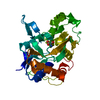
 Components
Components NMDA receptor
NMDA receptor
 Rattus norvegicus (Norway rat) / Gene: NMDAR1 / Organ: forebrain / Plasmid: pET22b(+) / Production host:
Rattus norvegicus (Norway rat) / Gene: NMDAR1 / Organ: forebrain / Plasmid: pET22b(+) / Production host: 
 Escherichia coli (E. coli) / Strain (production host): OrigamiB (DE3) / References: UniProt: P35439
Escherichia coli (E. coli) / Strain (production host): OrigamiB (DE3) / References: UniProt: P35439 Serine
Serine Water
Water X-RAY DIFFRACTION / Number of used crystals: 1
X-RAY DIFFRACTION / Number of used crystals: 1  Sample preparation
Sample preparation
 SYNCHROTRON / Site:
SYNCHROTRON / Site:  NSLS
NSLS  / Beamline: X4A / Wavelength: 0.9795 Å
/ Beamline: X4A / Wavelength: 0.9795 Å : 0.9795 Å / Relative weight: 1
: 0.9795 Å / Relative weight: 1  Processing
Processing :
:  FOURIER SYNTHESIS / Resolution: 1.45→9.99 Å / Rfactor Rfree error: 0.003 / Isotropic thermal model: RESTRAINED / Cross valid method: THROUGHOUT / σ(F): 0
FOURIER SYNTHESIS / Resolution: 1.45→9.99 Å / Rfactor Rfree error: 0.003 / Isotropic thermal model: RESTRAINED / Cross valid method: THROUGHOUT / σ(F): 0  Movie
Movie Controller
Controller



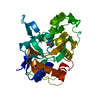


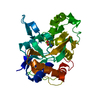


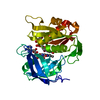




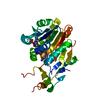
 PDBj
PDBj



